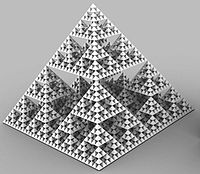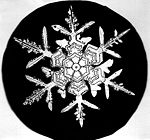- P-adic quantum mechanics
-
 One may compute the energy levels for a potential well like this one.[note 1]
One may compute the energy levels for a potential well like this one.[note 1]
P-adic quantum mechanics is a relatively recent approach to understanding the nature of fundamental physics. It is the application of p-adic analysis to quantum mechanics. The p-adic numbers are a counterintuitive arithmetic system that was discovered by the German mathematician Kurt Hensel in about 1899. The closely related Adeles and Ideles were introduced in the 1930s by André Weil. Their study has now transformed into a major branch of mathematics. They were occasionally applied to the physical sciences, but it wasn't until a publication by the Russian mathematician Volovich in 1987 that the subject was taken seriously.[1] There are now hundreds of research articles on the subject,[2][3] along with international journals as well.
This article provides an introduction to the subject, followed by a review of the mathematical concepts involved. It then considers modern research on the subject, from Schrodinger-like equations to more exploratory ideas. Finally it lists some precise examples that have been considered.
Contents
Introduction
Many studies of nature deal with questions that occur at the Planck length, in which ordinary reality doesn't seem to exist. In some ways, the experimental apparatus and experimenter become indistinguishable, so that no experiments can be done. The unification of the immensity of cosmology with the Hilbert space formalism of nanotechnology presents a formidable challenge. Most researchers feel that the geometry and topology of the sub-Planck lengths need not have any relation whatever to ordinary geometry and topology.[4] Instead the latter are believed to emerge from the former, just as the color of flowers emerges from atoms. Currently many frameworks have been proposed, and p-adic analysis is a reasonable candidate, having several accomplishments in its favor.
Another motivation for applying p-adic analysis to science is that the divergences that plague quantum field theory remain problematic as well. It is felt that by exploring different approaches, such inelegant techniques as renormalization might become unnecessary.[5] Another consideration is that since no primes have any special status in p-adic analysis, it might be more natural and instructive to work with adeles.
There are also aesthetic considerations, including those stemming from music. For instance, if one plays the overtones of a violin string, one notices that there are overtones at half the length, a quarter of the length, an eighth of the length, and so on. Those would correspond to the 2-adic integers. The same is true of the 3-adic integers, and so on for all primes. There are no other standing waves because non-integer values will cancel out. Thinking of nature as the overtones of n-dimensional strings is appealing to many people.[note 2]
There are two main approaches to the subject.[6][7] The first considers particles in a p-adic potential well, and the goal is to find solutions with smoothly varying complex-valued wavefunctions. Here the solutions to have a certain amount of familiarity from ordinary life. The second considers particles in p-adic potential wells, and the goal is to find p-adic valued wavefunctions. In this case, the physical interpretation is more difficult. Yet the math often exhibits striking characteristics, therefore people continue to explore it. The situation was summed up in 2005 by one scientist as follows: "I simply cannot think of all this as a sequence of amusing accidents and dismiss it as a 'toy model'. I think more work on this is both needed and worthwhile."[8]
Review of p-adic and adelic analysis
The ordinary real numbers are familiar to everyone. Still reasonably familiar, but less so, are the integers mod n. They are sometimes studied in courses on number theory, but are often regarded as a curiousity. It turns out that they have major significance. The reason they work is that they are a subset of the p-adic integers. Ostrowski's theorem states that there are essentially only two completions of the rational numbers, depending on the metric considered: these are the real numbers and the p-adic numbers. One completes the rationals by adding the limit of all Cauchy sequences to the set. The completions are different because of the two different ways of measuring distance.[note 3] The former obey a triangle inequality of the form |x+y| ≤ |x| + |y|, but the latter obey the stronger form of |x+y| ≤ max{|x|, |y|}; this is sometimes called an ultrametric space. In summary, there exist two different types of algebraic systems.
There is a question of how to unify these two foundational ideas, as they behave very differently in both space and time. This is solved by considering the patterns that occur, when one welds them together into a single mathematical object. This is the ring of adeles. It is of the form
where
 is a real number, and the xp are in
is a real number, and the xp are in  . The infinity sign in
. The infinity sign in  stands for the "prime at infinity". So an adele ring is essentially a direct product. The idele group is defined as the essentially invertible elements:
stands for the "prime at infinity". So an adele ring is essentially a direct product. The idele group is defined as the essentially invertible elements:Many familiar structures carry over to the adeles. For example, trigonometric functions, ex and log (x) have been constructed, as well as special functions like the Riemann zeta function, along with integral transforms like the Mellin and Fourier transform.[9] This ring has many interesting properties. For instance, it obeys the Hasse local-global principle: a rational number is the solution of a polynomial equation if and only is it has a solution in R and Qp for all primes p.[6] In addition, the real and p-adic norms are related to each other by the remarkable adelic product formula:[10]
where is a nonzero rational number. For example, one might consider the number 12. In this case, r2 = 0011, r3 = 011, r5 = 22, r7 = 51 and r11 = 11. So |r2| = 1/4, |r3| = 1/3, |r5| = 1, |r7| = 1, |r11| = 1, and all the rest are ones. Hence, 12*1/4*1/3*1*1*1*1*1*1*1 = 1. In string theory, a similar product formula holds not only at the tree level, but generalization to full amplitudes has also been proposed.[3] This is covered in more detail later in the article.
The p-adic numbers also furnish unusual proofs. For instance, one might consider the Pythagoreans, who were famous for insisting that all numbers were rational. Had they been aware of p-adic numbers, they would have found out quickly that this is not so. For consider √p, where p is a prime number. It is well known that there exists a minimal extension of the p-adic numbers of the form a+b√p. Therefore √p is not in Qp. But Qp contains all possible rationals. Therefore there are an infinity of irrationals. Writing this in the most condensed notation possible, one has the following rigorous proof:
-
 .
.
The research
- Fractal potential wells
Many upper-division science students are familiar with the particle in a box, or the particle in a ring. But there are also other types of potential wells. For instance, one may also consider the fractal potential wells. The solution of Schrodinger-like equations for potentials of this kind has been of interest for some time. Not only is it challenging to solve for puzzles like this, but it can be used for approximating complicated potentials as well, such as those that arise in the design of microchips. For example, one group of authors study the Schrödinger equation as it applies to a self-similar potential.[11] Another group studied the potentials constructed from the Riemann zeros and prime number sequences. They estimate the fractal dimension to be D = 1.5 for the Riemann zeros, and D = 1.8 for the prime numbers.[12]
The question of what happens when waves interact with fractal structures has been studied by many researchers.[13][14] The p-adic numbers are an excellent method for constructing fractal potential wells. For instance, one might consider a Dirac potential. This is simply a flat plane that contains a negative-valued Dirac delta function. One can think of this as a positive integer surrounded by zeros, and each of those surrounded by zeros, and each of those surrounded by zeros, and so on. As another example, one may think of a number surrounded by half its value, and each of those numbers by half their value, and so on. In this case it is more interesting, because half of 3 mod 7 is 5; therefore it seems to be bigger.
- Path integrals
As early as 1965, Feynman had stated that path integrals have fractal-like properties.[15] And, as there does not exist a suitable p-adic Schrodinger equation,[16][17] path integrals are employed instead. One author states that "Feynman's adelic path integral is a fundamental object in mathematical physics of quantum phenomena".[18] In order to do computations, certain details have to be made precise. For instance, one may define a meaningful derivative operator. In addition, both A and A* have a translation-invariant Haar measure:[19]
This allows one to compute integrals. For the sum over histories, Gaussian integrals are vital. It turns out that Gaussian integrals satisfy a generalization of the adelic product formula introduced before, namely:[19]
where
 is an additive character from the adeles to C given by[19]
is an additive character from the adeles to C given by[19]and
 is the fractional part of
is the fractional part of  in the ordinary p-adic expression for x. This can be thought of as a strong generalization of the homomorphism
in the ordinary p-adic expression for x. This can be thought of as a strong generalization of the homomorphismNow the adelic path integral, with input parameters in A and generating complex-valued wavefunctions is[20]
and similar to the case for real parameters, the eigenvalue problem is[20]
where
 is the time-development operator,
is the time-development operator,  are adelic eigenfunctions, and
are adelic eigenfunctions, and  is the adelic energy. Here the notation has been simplified by using the subscript
is the adelic energy. Here the notation has been simplified by using the subscript  , which stands for all primes including the prime at infinity. One notices the additive character
, which stands for all primes including the prime at infinity. One notices the additive character  which allows these to be complex-valued integrals. The path integral can be generalized to p-adic time as well.[21]
which allows these to be complex-valued integrals. The path integral can be generalized to p-adic time as well.[21]- Lorentz group
The p-adic generalization of the Lorentz group has been considered.[22] In 2008, an article was published on the group, in fields over primes congruent to 7 mod 8.[23] The author finds dense subsets of the group over the rationals, maps them to the group over the p-adic numbers, and finally to the group over the integers mod a prime. In this way, arbitrarily dense subsets of the group can be found.
- Finite fields
The research has not been limited to the inverse limit of the integers mod a prime number, because all finite fields have similar constructions. In fact, every finite field is the quotient of an ideal of that inverse limit, and therefore the system is actually a tower of ideals. The study of quantum mechanics in finite fields has been considered by a number of authors.[24][25] One motivation is that if spacetime is discrete, then perhaps continuous spacetime can be viewed as an approximation to finite fields. The theory of supersymmetry has been studied in finite fields as well.[26]
- Riemann zeta function
It can be shown that ground state of adelic quantum harmonic oscillator is[19][27]
where
 is 1 if
is 1 if  is a p-adic integer, and 0 otherwise. One notices the close similarity to the ordinary complex-valued ground state. Applying the adelic version of the Mellin transform, we have
is a p-adic integer, and 0 otherwise. One notices the close similarity to the ordinary complex-valued ground state. Applying the adelic version of the Mellin transform, we havewhere
 is the gamma function, and
is the gamma function, and  is the Riemann zeta function. Now there is a famous functional equation called the Tate formula, which says that
is the Riemann zeta function. Now there is a famous functional equation called the Tate formula, which says thatHere the left hand side is the Mellin transform, and the right hand side is the Mellin transform of the Fourier transform. But just as in the ordinary case, the Fourier transform does not change the result. So one can apply this formula to the previous one, and we arrive at the famous functional relation for the Riemann zeta function:
"It is remarkable that such simple physical system as harmonic oscillator is related to so significant mathematical object as the Reimann zeta function".[6] In addition, the statistical mechanics partition function for the free Riemann gas[note 4] is given by the Riemann zeta function:
- Veneziano amplitude
Another application involves the adelic product formula in a different way. In string theory, one computes crossing symmetric Veneziano amplitudes. The amplitude A (a, b) describes the scattering of four tachyons in the 26-dimensional open bosonic string. These amplitudes are not easy to compute. However, in 1987 an adelic product formula for this was discovered; it is[6]
This allows the four-point amplitudes, and all higher amplitudes to be computed at the tree level exactly, as the inverse of the much simpler p-adic amplitudes. This discovery has generated a quite a bit of activity in string theory.[28] The situation is not as easy for the closed bosonic string, but studies are still being pursued.
- Representation theory
P-adic representation theory has been extensively studied. One group of authors studies the structure of elementary particles, by means of the projective representations of the p-adic Poincare group. This a generalization of the famous theorem of Wigner, who showed that all projective unitary representations of the poincare group lift to unitary representations of its (universal) double cover. They show that the p-adic version of massive particles cannot have conformal symmetry, by studying the embedding of the p-adic poincare group into the p-adic conformal spacetime.[5] Another group studied p-adic symplectic theory; more specifically, the representations of GL(2n) over a p-adic field that admit an invariant under the symplectic group.[29] Yet another has studied "extrametaplectic" representations.[30]
- Principal bundles
The math associated with this study is elegantly formulated in the language of gauge theory. In particular, one studies the wavefunctions in a tangent space known as a principal bundle. This helps to formulate a self-consistent theory. In this case, there is an idele-group bundle. It can be matrix-valued, in which case it may be noncommutative as well.
- Quantum cosmology
The theory has also been applied to quantum cosmology.[31] One group of authors study the relevance of "quantum rolling tachyons and corresponding inflation scenario" in terms of adelic quantum cosmology.[32]
Examples
This section presents concrete examples of fractal or adelic systems which have been studied.
One dimensional systems
The following one dimensional systems have been studied by means of the path integral formulation: the free particle,[2] the particle in a constant field,[33] the harmonic oscillator,[9] and others as well.
Particle on a Sierpinski gasket
Percolation theory is used by many to study the behaviour of integrated circuits and other designs. This is because the materials are so small that they qualify for disordered materials theory. Many disordered materials "exhibit geometrical inhomogeneties over a broad range of length scales".[34] More importantly, near the percolation threshold, the geometry is fractal. This is well known from the theory of phase transitions. In 2011, one group studied potential theory on the Sierpinski gasket.[34] They develop a mathematical formalism, and show how it can be used to develop a potential theory on this space, even though it is technically not a manifold. Another group studied Josephson junction arrays of periodically repeated Sierpinski gaskets.[35]
Particle on a Cantor set
One group numerically solve a rescaled version of the Schrodinger equation for a particle in a Cantor-like potential.[36]
Notes
- ^ There is no known analytical solution. Instead, numerical techniques are used to solve puzzles of this type.
- ^ It should be noted that this idea is different from ordinary string theory.
- ^ The two spaces are complete as a metric space, but neither are algebraically complete. That requires generalizing to an infinite-dimensional space.
- ^ This is not a real gas, but rather a fictitious one. One might think of the famous experiment of heating up hydrogen gas, and viewing the spectral lines. In the same way, heating up the free Riemann gas would allow one to view (the differences of) a series based on the prime numbers.
References
- ^ I.V.Volovich, Number theory as the ultimate theory, CERN preprint, CERN-TH.4791/87
- ^ a b V. S. Vladimirov, P-adic Analyisis and Mathematical Physics, (World Scientific, Singapore 1994)
- ^ a b L. Brekke and P. G. O. Freund, P-adic numbers in physics, Phys. Rep. 233, 1-66(1993)
- ^ These ideas are considered in a huge number of articles by Fotini Markopoulou and her colleagues. Any search engine should provide many results.
- ^ a b http://www.arxiv.org:1002.0047, Structure, classification, and conformal symmetry of elementary particles over non-archimedean space-time, V. S. Varadarajan, Jukka T. Virtanen
- ^ a b c d Branko Dragovich, Adeles in Mathematical Physics (2007), http://arxiv.org/abs/0707.3876
- ^ page 3, second paragraph, Goran S. Djordjevic and Branko Dragovich, p-Adic and Adelic Harmonic Oscillator with Time-Dependent Frequency, http://arxiv.org/abs/quant-ph/0005027
- ^ Peter G.O. Freund, p-adic Strings and their Applications, http://arxiv.org/abs/hep-th/0510192
- ^ a b Branko Dragovich, Adelic Harmonic Oscillator, http://arxiv.org/abs/hep-th/0404160
- ^ Branko Dragovich, Andrei Khrennikov and Dusan Mihajlovic, Linear Fractional p-Adic and Adelic Dynamical Systems, http://arxiv.org/abs/math-ph/0612058
- ^ N L Chuprikov, O V Spiridonova, A new type of solutions of the Schrödinger equation on a self-similar fractal potential, http://www.arxiv:quant-ph/0607097
- ^ Brandon P. van Zyl, D. A. W. Hutchinson, Riemann zeros, prime numbers and fractal potentials, http://arxiv.org/abs/nlin/0304038
- ^ M. Berry, J. Phys. A 12, 781 (1979)
- ^ F. Bihua and F. Duan, Chem. Phys. Lett. 5, 9(1988)
- ^ R. P. Feynman and A. R. Hibbs, Quantum Mechanics and Path Integrals, (McGraw-Hill, 1965)
- ^ Page two, last paragraph, arxiv:0804.1328, Quantum Cosmology and Tachyons, D. D. Dimitrijevic, G. S. Djordjevic, Lj. Nesic
- ^ Also page two, last paragraph, arxiv:1011.6589, Path Integrals for Quadratic Lagrangians on p-Adic and Adelic Spaces, Branko Dragovich
- ^ Branko Dragovich, Path Integrals for Quadratic Lagrangians on p-Adic and Adelic Spaces, http://arxiv.org/abs/1011.6589
- ^ a b c d Branko Dragovich, On Generalized Functions in Adelic Quantum Mechanics, http://arxiv.org/abs/math-ph/0404076
- ^ a b Branko Dragovich, p-Adic and Adelic Quantum Mechanics, http://arxiv.org/abs/hep-th/0312046
- ^ Branko Dragovich, On p-adic path integral, http://arxiv.org/abs/math-ph/0005020
- ^ E. G. Beltrametti, Note on the p-adic generalization of the lorentz transform, Discrete Mathematics, 1(1971), 139-146
- ^ Stephan Fouldes, The Lorentz group and its finite field analogues: local isomorphism and approximation, http://arxiv.org/abs/0805.1224
- ^ arxiv:hep-th/0605294, Quantum Theory and Galois Fields, Felix Lev
- ^ arxiv:hep-th/0209001, Elementary Particles in a Quantum Theory Over a Galois Field, Felix Lev
- ^ arxiv:hep-th/0209229, Supersymmetry in Quantum Theory Over a Galois Field, Felix Lev
- ^ arxiv:hep-th/0402193, Adelic Model of Harmonic Oscillator, Branko Dragovich
- ^ Debashis Ghoshal, Quantum Extended Arithmetic Veneziano Amplitude, http://arxiv.org/abs/math-ph/0606003
- ^ arxiv:0806.4031, On Unitary Representations of GL2n Distinguished by the Symplectic Group, Omer Offen, Eitan Sayag
- ^ arxiv:0903.1417, Multiplicity one theorems for Fourier-Jacobi models, Binyong Sun
- ^ Branko Dragovich and Ljubisa Nesic, p-Adic and Adelic Generalization of Quantum Cosmology, http://arxiv.org/abs/gr-qc/0005103
- ^ G. S. Djordjevic and Lj. Nesic, Non-archimedean quantum cosmology and tachyonic inflation, http://arxiv.org/abs/1011.2885
- ^ Branko Dragovich, On p-adic functional integration, Proc of the II mathematical conference, Yugoslavia, (1997) 221-228
- ^ a b http://arxiv.org/PS_cache/arxiv/pdf/1105/1105.1995v1.pdf, Differential 1-forms, their Integrals and Potential Theory on the Sierpinski Gasket, Fabio Cipriani, Daniele Guido, Tommaso Isola, Jean-Luc Sauvageot
- ^ arxiv:0205105, Dimensional crossover and hidden incommensurability in Josephson junction arrays of periodically repeated Sierpinski gaskets, R.Meyer, S.E.Korshunov, Ch.Leemann, P.Martinoli
- ^ D. Hadjimichef, Bound-State Problem in a One-Dimensional Cantor-like Potential, http://arxiv.org/abs/quant-ph/9806064
Categories: -
Wikimedia Foundation. 2010.



















